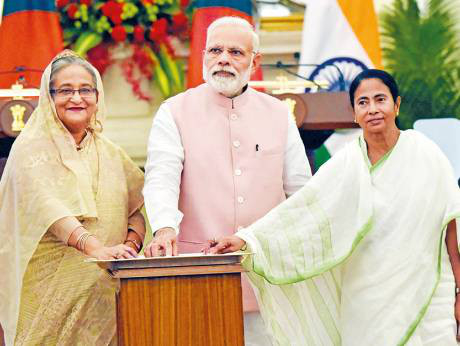
Bangladesh Prime Minister Shaikh Hasina’s fairly fruitful India-trip early this month has further strengthened the bonds of friendship between the two south Asian neighbours, which has been aptly likened to a flowing river by the visiting dignitary. Sharing the world’s fifth-longest land boundary and close historical, cultural and ethnic affinities, both New Delhi and Dhaka have assiduously nurtured a relation that has stood the test of time. In fact, the broad content of India-Bangladesh bilateral relations has been changing for the better and had undergone a radical shift when former Indian Premier Manmohan Singh agreed to resolve all long-pending disputes urgently and develop a shared vision for regional peace and prosperity through cooperative action.
Indeed, the two nations are fast emerging as leading economic partners in south Asia whose collective strengths can transform the socioeconomic scenario of the extended region and the world, too. As Farooq Sobhan, Bangladesh’s former foreign secretary and president of Bangladesh Enterprise Institute, acknowledges candidly, “Prime Minister Hasina’s return visit, seven years after her landmark trip of 2010 ushered a new dawn in bilateral ties, has resulted in several major developments in multiple areas, particularly in the fields of connectivity, trade, investment and energy cooperation.”
‘Blue Economy’
Having emerged as one of the two fastest growing economies globally, with Goldman Sachs terming it “the miracle of East,” Bangladesh is in an ideal position to partner India in transforming the socioeconomic face of South Asia positively.
Apart from strengthening economic cooperation through joint investments and sustained partnership at various levels, the leaderships of both nations are putting special emphasis on the ‘Blue Economy’ — covering maritime value chains with considerable forward and backward linkages — as a tool for achieving sustainable development by way of a synergised effort in offshore hydrocarbon exploration, management of marine resources, deep-sea fishing, preservation of marine ecology, bolstering disaster management and mitigation strategies. “This commitment from both governments, of developing Blue Economy linkages, would be a timely force-multiplier not just for bilateral relations but also regional cooperation” believes Alwyn Didar Singh, a former secretary to the Government of India and currently Secretary General of the Federation of Indian Chambers of Commerce and Industry.
Since trade potential between India and Bangladesh is four times the current volume of $6.6 billion (Dh31 billion), Didar Singh feels “this is the right time to build intra-regional connectivity to boost trade and tourism with a bounty of $70 billion incremental GDP and 20 million jobs by 2025.”
Energy cooperation
Energy cooperation has become the cornerstone of India-Bangladesh relations in recent years, with cross-border power connectivity not only enhancing the level of trust existing between the two nations, but also opening up the possibility of unleashing the forces of pan-South Asian integration in making the region power-sufficient.
“Power and energy will be a great geopolitical binding factor in South Asia more than anything else,” predicts Bangladesh’s minister of state for power, energy and mineral resources, Nasrul Hamid. That energy security is the plinth on which India’s massive economic initiative in her immediate neighbourhood stands is reflected in the fact that power and gas leads the $9 billion investment projects that the Indian government has proposed to bolster Bangladesh’s existing industrial base.
According to Hamid, India and Bangladesh’s understanding on energy issues in recent times has been exemplary, with the joint steering committee for power achieving phenomenal feats. “Besides the plan to bring power through Myanmar, addition of Nepalese and Bhutanese hydro-power potential will make South Asia better integrated than many other regions in the world in terms of energy security,” says Hamid, adding, “Dhaka is keen to align with India’s proposed power transmission link, connecting the landlocked north-east with the rest of the country, apart from seeking seamless flow of cross-border electricity through high-voltage, direct-current transmission lines.”
Moreover, having inked a civil nuclear agreement, Bangladesh can certainly benefit from India’s pioneering, alternative-thorium-based nuclear technology for accessing cheaper, safer and cleaner energy. And most importantly, connectivity infrastructure (railways, roadways, ports) is expected to be the big game-changer as India eyes transit to Southeast Asia via Bangladesh.
Water woes
Despite many positive developments in India-Bangladesh relations, water-sharing continues to be a prickly thorn. The stalemate over the Teesta river water sharing agreement, because the river is left with only one-16th of water needed for agriculture in India and Bangladesh during the lean season, is affecting the livelihoods of approximately 9.15 million people. Given Bangladesh’s apprehension about India’s river-interlinking project — a viable option for enhancing water flow in Teesta — perhaps the only other way to get out of this tangle is to exploit the excess water available in the monsoon season, which is more than double the agricultural needs of two nations.
Institutionalising a coordination mechanism for synchronisation of storage and release of water from upstream barrages and hydro-power units in accordance with farming requirements is the only way out. Professor Ainun Nishat, an eminent water expert and ex-member of the Indo-Bangladesh Joint River Commission advocates “a sharing arrangement for the dry season to be followed by comprehensive basin-wise and basin-wide water resources management.”
Seema Sengupta is a Calcutta based journalist and columnist.








